#viennese design
Explore tagged Tumblr posts
Text

Fluted columns of light double as pedestals in Klaus Reymann's playful and sophisticated wall treatment. The objects displayed appear to float - as do the glasses and bottles in the backlit bar recess. The Josef Hoffmann fabric on the wall forms a harmonious surround for the classic Viennese lines of the table and chairs.
Rooms by Design, 1989
#vintage#vintage interior#1980s#80s#interior design#home decor#dining room#wallpaper#Klaus Reymann#bar#Viennese#contemporary#style#home#architecture
122 notes
·
View notes
Text

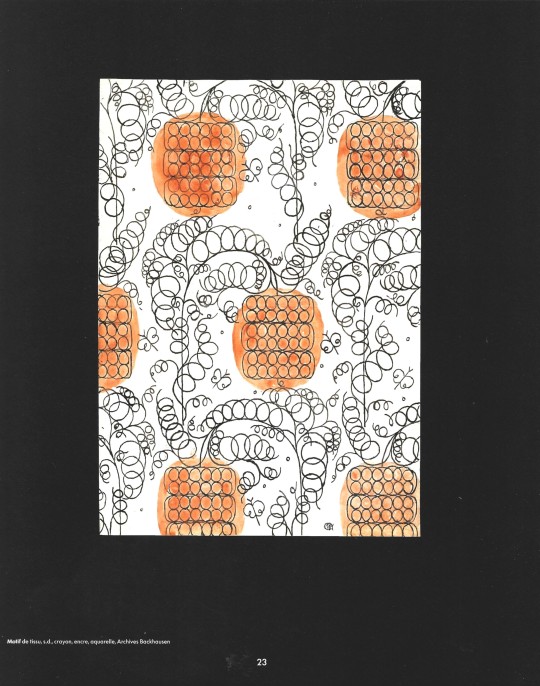
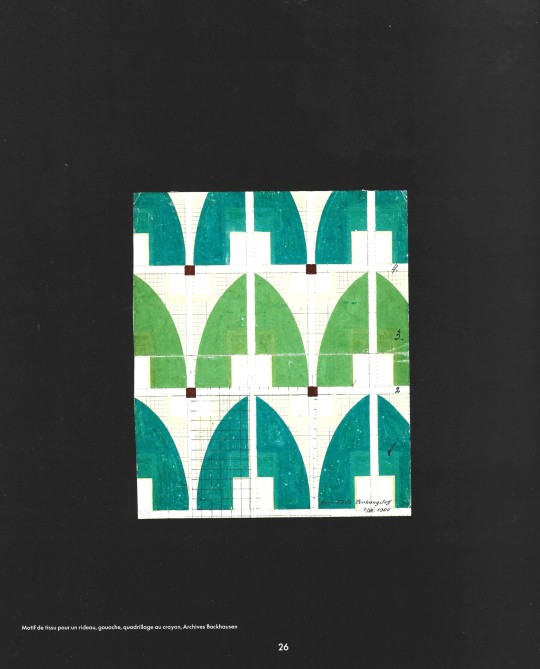
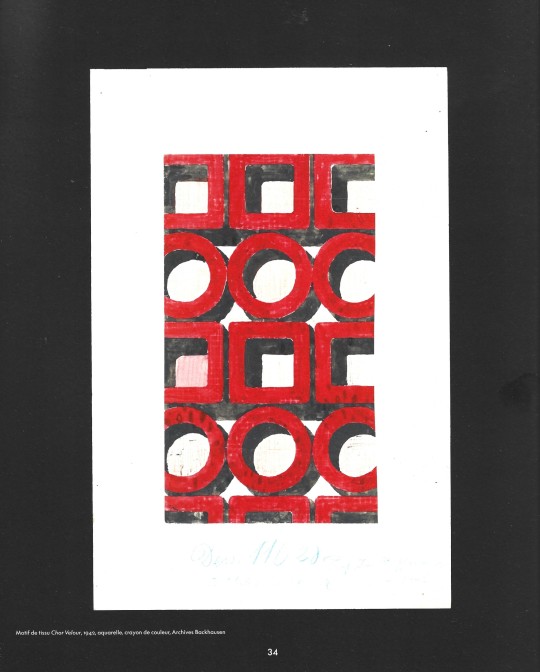
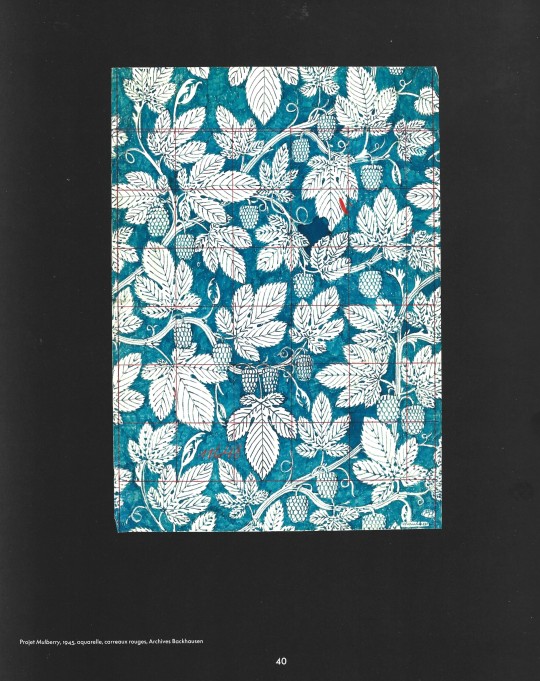



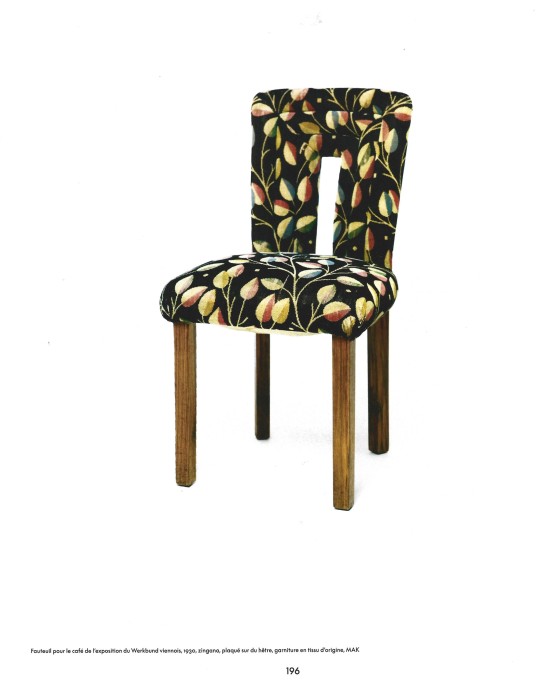
Josef Hoffmann
Sous le charme de la beauté
Adrián Prieto, Christian Witt-Dörring
Hannibal, Veurne 2023, 208 pages, Hardcover,24,5x28cm, French Edition, ISBN 978 94 6466 668 7
euro 60,00
email if you want to buy [email protected]
Innovative introduction to the iconic work of architect and designer Josef Hoffmann
The Viennese architect and 'all-round designer' Josef Hoffmann (1870–1956) is so much more than the founder of the Wiener Werkstätte. This book offers a broad view of his oeuvre that developed over no less than sixty years. The timeless beauty of Hoffmann's creations shows not only his importance as a historical figure, but also as a source of inspiration for several generations.
Richly illustrated with furniture, objects, designs, textiles, photographs, drawings and documents. Special attention is paid to his creative working method and his misunderstood use of color.
This monograph is published on the occasion of the exhibition Josef Hoffmann – Under the spell of beauty, which will take place from October 6, 2023 to April 14, 2024 in the Brussels Museum of Art & History. The project was created in collaboration with the Museum für angewandte Kunst (MAK) in Vienna and is one of the eye-catchers of the Art Nouveau Year 2023 in Brussels.
13/11/23
#Josef Hoffmann#architect and designer#Brussels Museum of Art 2024#viennese architect#Wiener Werkstatte#furnitures#textiles#objects#drawings#designbooksmilano#fashionbooksmilano
23 notes
·
View notes
Text
Hélène Funke (DE|AT, 1869 - 1957)
Helene Funke (3 September 1869 – 31 July 1957) was a German-Austrian painter and graphic designer of modern times. From 1905 and until 1913, she lived in France and then moved to Vienna until her death. In 1918 she became a member of the artist group “movement” or “free movement” (from 1919). In addition, she was a member of the group of Viennese women’s art. In 1928 she received the Austrian…

View On WordPress
#art herstory#Österreichische Galerie Belvedere#exhibition City Of Women#Female artists in Vienna from 1900 to 1938#forgotten painters#German-Austrian#graphic designer#great women artists#Helene Funke#Kunsthandel Hieke#painter#Viennese women&039;s art#Women&039;s Art
1 note
·
View note
Text
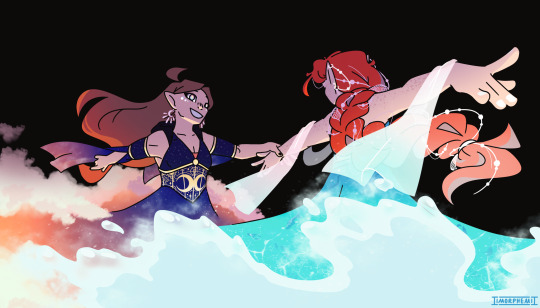
Day 598
As a ballroom girlie I am legally required to draw Pearl ballroom dancing as per her latest Hermitcraft episode of building a ballroom. So I asked Mod Cosmic to pick a hermit for her to dance with and she also helped design Pearl's dress and pushed me to go FULL fantasy with their dresses which I'm SO happy she did
I know Gem is usually more affiliated with like nature and plants and stuff but I really wanted to put waves on her dress, and also the duality of the sky and the sea is very very good and I am a big fan of it aha
(By the way they're dancing viennese waltz and Pearl is leading)
(still on indefinite hiatus ^^;;;)
#daily pearl doodles#pearlescentmoon#geminitay#mod morph#hermitcraft#now it is not recommended for both dancers to be wearing a dress when it comes to ballroom#because the focus of the dance can get confusing#this is referring to competition and performance btw#uhhh with the flare it could also interfere if both dresses are kind of big#for yknow collision reasons#BUT THIS IS ART AND WE CAN DO WHATEVER WE WANT BABEY THEYRE BOTH IN DRESSES
723 notes
·
View notes
Text
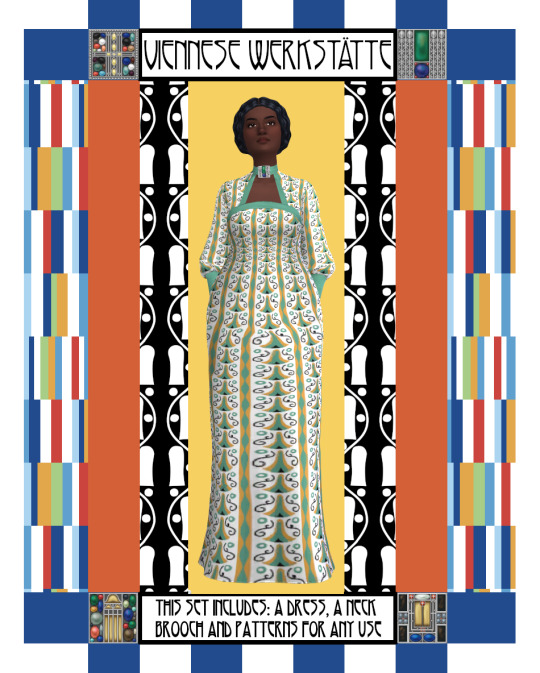
Viennese Werkstätte
This set is inspired by the Wiener Werkstätte, an association of viennese artists which was active in the early 20th century. It includes a dress, a brooch and a collection of patterns.
More pics and download below
——————————— Patterns ——————————
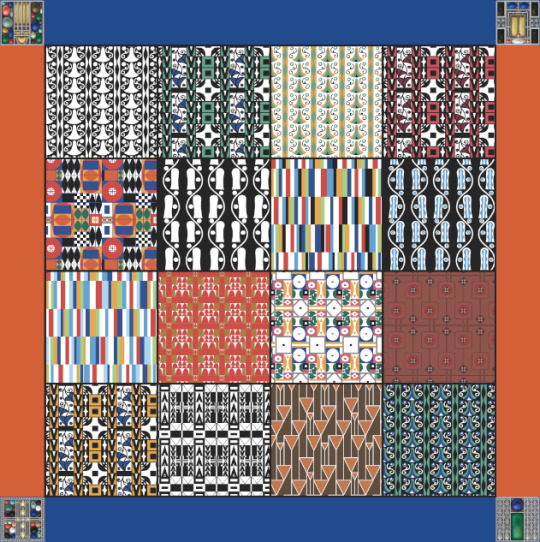
I based all of these motifs on Wiener Werkstätte extent pieces (fabrics, book covers and sketches) ranging from 1907 to the 20s (the dates are pretty vague for most of these). Feel free to use them for anything : clothes, upholstery, wallpaper etc.
Please do tag me if you make anything out of these ! ❤️
Includes psd and gimp files for each as well as png in 2 scale options.
——————————— Brooch ——————————
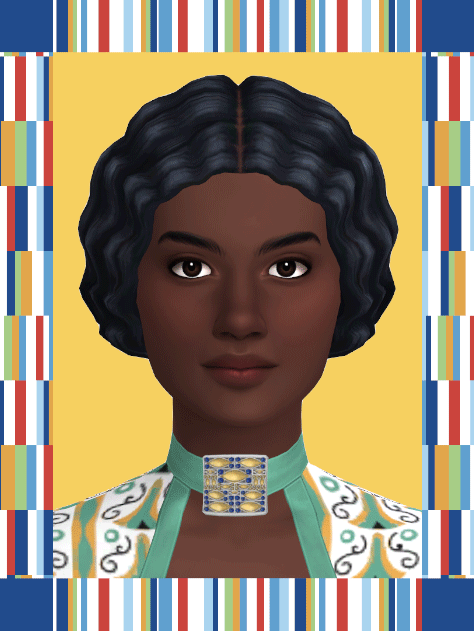
I admittedly got a bit obsessed with Wiener Werkstätte brooches which I've seen mostly worn on the neck (after all they were also called "plaque de cou" aka "neck badge") in photos of Emilie Flöge, so I had to recreate some. The brooches after which I modeled mine were all designed between 1904 and 1908 but I have an inkling that they'd look great on some 60s/70s looks too.
in the necklace section
16 swatches : 7 different design available in different orientations
available for female frames
——————————— Dress ——————————
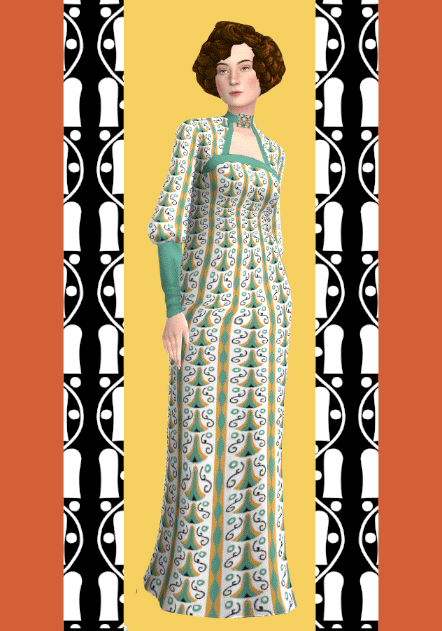
I had to put all these good motifs to use so I made this recolor of my Flöge V1 dress to keep to the Wiener Werkstätte theme !
the mesh is included
17 swatches
available for female frames
———————————————————————————
Download : dropbox — simfileshare
———————————————————————————
And some bonus reference pictures below
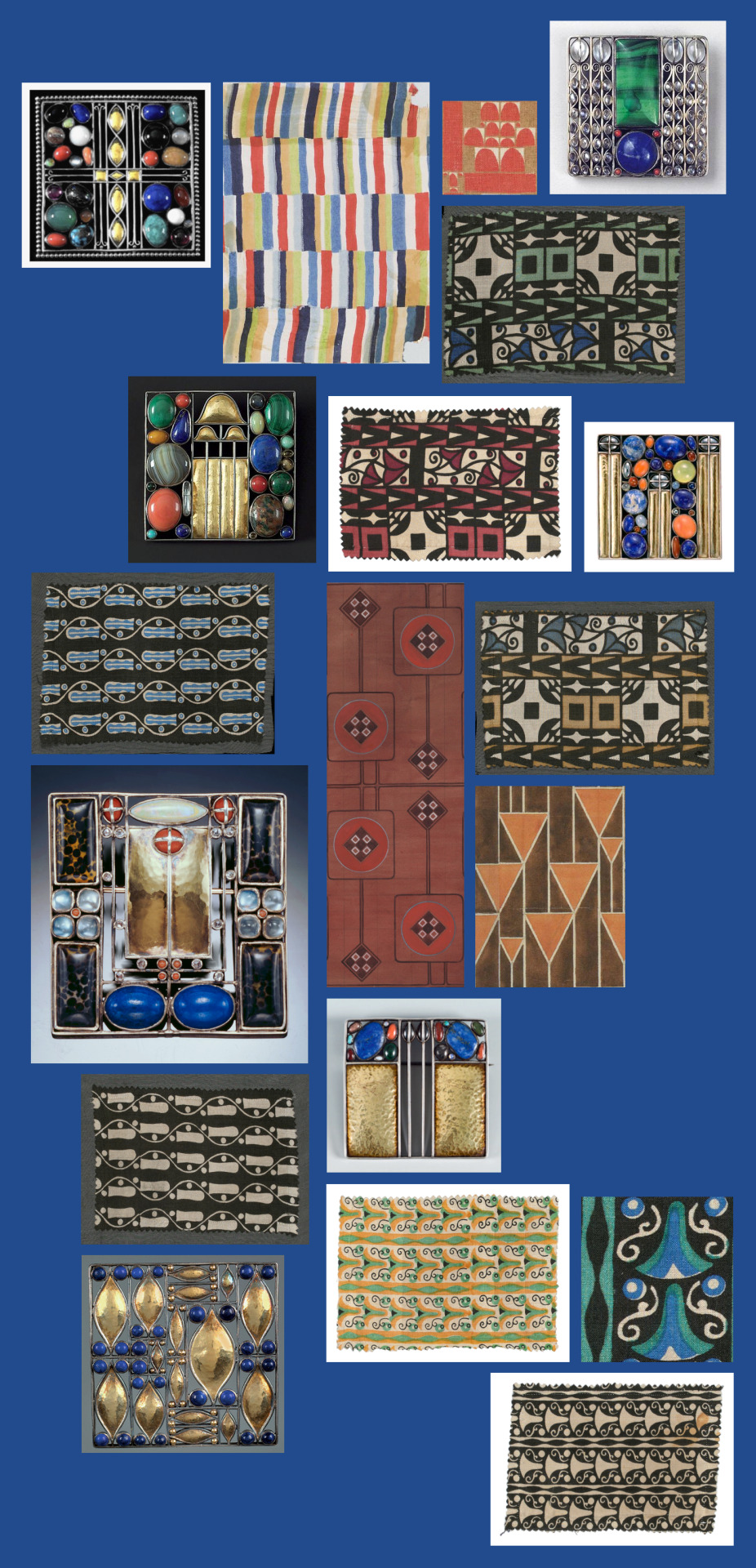
#my cc#ts4cc#ts4 historical#ts4 clothes#sims 4 historical#sims 4 clothes#maxis match#pattern#seamless pattern#wiener werkstätte#chere-indolente#1900#grown up#clothes#jewellery#accessories#resources#Viennese Werksträtte
184 notes
·
View notes
Text

How David Bowie inspired Eddie Redmayne’s ‘Day of the Jackal’ transformations.
Gold Derby, May 6, 2025 . 📸 Photo by Marcel Pitti.
Eddie Redmayne, who stars as the chameleon assassin in Peacock’s adaptation of The Day of the Jackal, credited his frequent collaborator, Alexandra Reynolds — whom he’s worked with since playing Stephen Hawking in The Theory of Everything — with tipping him off to David Bowie’s philosophy on costumes.
“She helped me with some of the different characters and the physicality of the different characters in this series,” Redmayne said at a Peacock FYC Q&A at the Lot on Formosa on Monday, noting how early in his career, Bowie appeared in makeup and costumes embodying characters like Ziggy Stardust. “She showed me this interview with David Bowie in the ’70s. It was the first interview he had done dressed as him.”
“Not only were we looking at it for his stillness and his almost deference whilst being completely in charge of the situation,” Redmayne continued. “You were so drawn to him but he’s talking about using clothes as disguise, being away from himself really. That particular video I would play every morning in my trailer and was a big influence.”
The Jackal also wears prosthetic makeup to impersonate people. Behind the scenes, designing that makeup was not as glamorous as Bowie’s transformation.
“One of the more humiliating experiences of my life is standing basically buck naked, having loads of people slap Plaster of Paris on me to make a body cast,” he said.
Costume designer Natalie Humphries helped Redmayne transform. She also took him to Knize’s Viennese tailor shop as an example of expert costumers. Redmayne said he saw the Jackal as a fellow actor — albeit one playing roles for the purpose of killing people.
“The scripts that I first read by Ronan [Bennett] were a celebration in craft, whether that was the makeup, the languages, the physicality,” he said. “The scripts felt like they really dug into that, the idea of this assassin as performer and that was completely intoxicating.”
Perhaps too intoxicating. Now that the series has wrapped, Redmayne longs for the role, despite all the hard work it took to bring it to life.
“I do miss him,” Redmayne said. “I miss that little sociopath.”
In seeing the Jackal as a performer, Redmayne could play each of his personas as a new character. The audience knows the Jackal’s ulterior motives, but what makes him so unstoppable is that he believes it while he’s performing it.
“It made it quite thrilling to play because any circumstance he was in, I would just play it as honestly as possible,” Redmayne said. “The audience is reading something opposite from it but that was definitely one of the appeals.”
Frederick Forsyth’s 1971 novel was first adapted as a movie starring Edward Fox as the Jackal in 1973. The most challenging scene for Redmayne was an homage to the 1973 film, in which the Jackal shoots watermelons as target practice. But the hard part was tying the rope around the tree to mount the gun.
“I spent so long watching Edward Fox’s performance trying to work out how to do it,” he said. “I had a metal pole in my trailer and a rope. I spent about three f--king weeks. So I always admired this particular scene in the original movie. When it came to replicating it, my admiration for Edward Fox went through the roof.”
The Day of the Jackal is now streaming on Peacock.
28 notes
·
View notes
Text
New Yorker Rose Girone, who celebrated her 113th birthday on Jan. 13 and was believed to be the oldest living Holocaust survivor, died on Monday morning.
The cause, according to her daughter, Reha Bennicasa, was old age.
Girone — who ran a knitting shop in Forest Hills, Queens and credits the craft as helping to save her family during the Holocaust — was, by all accounts, a remarkable person, and was well-loved in New York’s knitting community. Girone was also outspoken about her experiences during the war; she provided testimonies to The USC Shoah Foundation, the Holocaust Memorial and Tolerance Center of Nassau County and others.
“Everything that’s out there is really who my mother was,” Bennicasa said, referring to the press coverage her mother received in recent years. “She was a strong lady, resilient. She made the best of terrible situations. She was very level-headed, very commonsensical. There was nothing I couldn’t bring to her to help me solve — ever — from childhood on. She was just a terrific lady… and I don’t know, when God made her, they broke mold.”
Born in Janov, Poland in 1912, Girone’s family settled in Hamburg, Germany, where they ran a theatrical costume shop. In 1938, Girone (née Raubvogel) married Julius Mannheim in an arranged marriage; later that year, the couple moved to Breslau, Germany (now Wroclaw, Poland), just as Kristallnacht launched waves of violence against Germany’s Jews. Mannheim was arrested and sent to the Buchenwald concentration camp and Girone, eight months pregnant, fled the city to stay out of harm’s way.
In 1939, Girone jumped at a chance to leave Nazi Germany: A cousin sent her a paper he said was a visa, written in Chinese. Shanghai was one of the last open ports in the world; Girone presented the visa to the Nazi authorities and was able to get Mannheim released from Buchenwald.
“They let my father out with the proviso that we pay them and get out of the country within six weeks, and so we did,” Bennicasa, now 86, told New York Jewish Week writer Tanya Singer in 2022.
Conditions in the Chinese city were difficult for the Jewish refugees, but Girone — who had learned to knit from an aunt as a child and took to it immediately — was able to find wool and knit clothes for her baby girl. Soon enough, an entrepreneurial Viennese Jewish man saw her creations and helped her sell her work and taught her about business.
The money Girone earned from selling her wares to an upscale Shanghai store provided much-needed income for her family. In 1947, when the family was granted a visa for the United States, knitting again played a crucial role in the family’s well-being: Each person was only permitted to leave China with $10, but Girone hid $80 cash inside buttons on her hand-knit sweaters.
They family traveled by ship to San Francisco and ultimately ended up in New York, where they were reunited with Girone’s mother, brother and grandmother, who had all survived the war.
Girone and Mannheim divorced and, in 1968, she met and married Jack Girone. They moved to Whitestone, Queens, where she thrived as a knitting teacher. Soon, she and a partner opened a knitting shop in Rego Park, Queens; they later expanded to a second location in Forest Hills. The partners later split and Girone became the sole owner of Rose’s Knitting Studio on Austin Street.
“Mother was pretty proud of all her designs,” Bennicasa told the New York Jewish Week in 2022. “People would bring ads from Vogue and the like and say they wanted something just like this particular picture. Some with intricate patterns, Mother would sit, figure it out, lots of times with graph paper. She loved it.”
In 1980, at 68, Girone sold her business — but she never stopped knitting.
According to the Long Island Herald, following the death of her husband, Girone lived alone at her apartment in Beechhurst, Queens until she was 103. After breaking her hip three years ago, Girone relocated to Belair Nursing & Rehabilitation Center in North Bellmore, which is close to Bennicasa and her daughter, Gina, who survive her.
As Girone told the Herald on her 113th birthday, “the secret to a long, healthy life is simple: Live every day with a purpose, have amazing children, and eat lots of dark chocolate.”
“She just was a terrific lady,” Bennicasa told the New York Jewish Week on Monday. “There was nothing that was too hard for her to think about doing. She was just great.”
She added, “We have an awful lot of people who thought that she was everybody’s Oma,” said Bennicasa, using the German word for grandma.
27 notes
·
View notes
Text
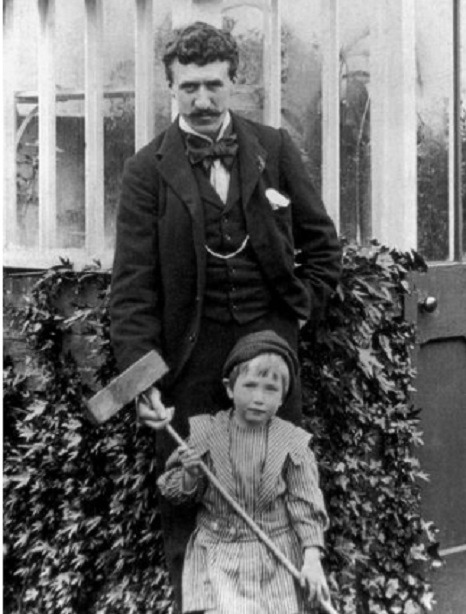


On 10th December 1928, the hugely influential architect and designer Charles Rennie Mackintosh died in London.
Charles Rennie Mackintosh was born in the East End of Glasgow in 1868, and is one of its most famous sons. He lived and worked in the city for much of his life, and it was during his studies at the Glasgow School of Art that he met his wife Margaret MacDonald. The pair formed a close artistic collaboration with Margaret’s sister Frances, and Frances’ husband Herbert MacNair, becoming known as ‘The Four’. As was advocated at the school at the time, the group worked cross-disciplinarily, producing designs in many mediums, from furniture to textiles.
Mackintosh is, of course, best known for his astoundingly unique and innovative architectural style. Celebrated today as a leading pioneer of modernism, he had a distinctive vernacular which absorbed traditional Scottish architecture, elements of modernist utilitarianism, and the understated, functional design of Japan (newly opened to the West). His designs, which also embraced natural forms (like his famous ‘rose’) as well as the mechanisation of the industrial revolution, influenced the Art Nouveau movement on the Continent, where his work was met with great acclaim during the eighth Viennese Secession Exhibition in 1900.
His success and productivity as an architect was short lived, with most of his high profile commissions taking place over a mere ten year period, between 1895-1906. As this work dried up, he turned his focus fully to working as an artist in watercolour. He and Macdonald moved to Walberswick, Suffolk in 1914, where he produced delicate and technical studies of flowers and plants. Struggling to make ends meet, the pair then moved to Port Vendres in the South of France, where his painting focused on the natural forms of the coastline juxtaposed against the manmade.
He returned to Britain through illness, and died in London at the age of 60. His legacy grew gradually in the decades after his death, and he is now a household name around the world.
Pics are of the man himself, a Statue of Charles Rennie Mackintosh unveiled on the 90th anniversary of his death in 2018. The sculptor is Andy Scott, one of his more conventional works, Andy’s other work includes The Kelpies. Next is Scotland Street School, designed by Charles Rennie Mackintosh between 1903 and 1906. The building is one of Glasgow's foremost architectural attractions. The Willow Tea Rooms is next, one of Glasgow’s famous treasures for locals and tourists, alike. Finally the sublime Glasgow School of Art library, severely damaged by fire in 2014, almost fully restored then destroyed by a second fire in June 2018, with sadly only the burnt-out shell remaining.
In October 2021 it was announced The Glasgow School of Art ruled out constructing a new building to replace its fire-ravaged Mackintosh building and had opted for a ‘faithful reinstatement’ of the 1909 architectural masterpiece
Explore the CRM website for much more........https://www.charlesrenniemac.co.uk/
23 notes
·
View notes
Text










Vanessa Bell, 1879 - 1961, British painter and designer.
The eldest of four children and sister of the future Virginia Woolf, Vanessa Bell was born to a wealthy and intellectual family: her mother, Julia Jackson, was the niece of a pioneering photographer, Julia Cameron, and one of the favourite models of the pre-Raphaelites; her father was Sir Leslie Stephen, a famous writer and alpinist. As a young woman, in 1901, she studied at the London Royal Academy of Art. After their parents died, the children continued to live together in central London. Within the Bloomsbury Group, Vanessa organised artistic evenings she called the “Friday Club.”
In 1907 she married the art critic Clive Bell, with whom she would have two sons. Her early paintings – Iceland Poppies (1908-1909), for example – show the joint influence of the American painters John Singer Sargent and James Abbott McNeill Whistler. She gradually became interested in Impressionism, particularly French post-Impressionism. A great admirer of Paul Cézanne, Camille Pissarro and Vincent Van Gogh, she painted portraits with synthetic outlines, simplified shapes and bold colours, like the portrait of her sister, Virginia Woolf (1912).
She made her first venture into decorative arts in 1910 with the Scottish painter Duncan Grant, with whom she had a daughter, Angelica, in 1918. The pair would work together throughout their lives. She painted boxes with geometric shapes that followed the aesthetic principle her husband had developed: the predominance of the “significant form” and of its outline and colour over the narrative subject. She took part in two exhibitions organised by Roger Fry in 1912: Quelques indépendants anglais (Barbazanges Gallery, Paris) and his second exhibition of post-impressionist art at the Grafton Galleries in London.
The following year, encouraged by Fry, she opened the Omega Workshops with Grant in London’s Fitzroy Square, where Woolf also lived. Inspired by the Wiener Werkstätte (the Viennese workshops) and Parisian fashion and interior design studios like Paul Poiret’s “Maison Martine,” the Omega Workshops employed artists on a daily basis to create fabric patterns, furniture, and interior design projects, thus promoting a dialogue between painting and decorative arts, in a search for equality between major and minor arts. In May 1914, she assisted Grant in Paris in the creation of costumes for Jacques Copeau’s staging of Twelfth Night, and visited the studios of Pablo Picasso and Henri Matisse. Upon returning to London, she created a special section devoted to fashion at Omega.
From the article by Cécile Godefroy
30 notes
·
View notes
Text

Julius Klinger (22 May 1876 – 1942) was an Austrian painter, draftsman, illustrator, commercial graphic artist, typographer and write
Klinger was persecuted by the fascists because he was Jewish. According to Viennese police records, he and his wife Emilie were registered as "Moved to Minsk" on 2 June 1942. This designation was synonymous during the Nazi era with deportation. Large numbers of Viennese Jews were murdered at the Maly Trostenets extermination camp near Minsk. It is presumed that Julius and Emilie suffered this fate in 1942 or soon after
—wiki
17 notes
·
View notes
Text


Liechtenstein Candy Charm Design
Includes:
-Fürstenhütchen
- Hofkellerei des Fürsten von Liechtenstein (Wine from the prince of Liechtenstein)
- Liechtensteiner Ribel
- Liechtensteiner Krömle (cookies but in the shape of Liechtenstein)
History Bar Code:
1342 - The county of Vaduz was founded due to a split of the county of Werdenberg
1681 - End of the witch trials of Triesen, between 1598 and 1680 more than 100 people were accused for witchcraft
1719 - The modern country of Liechtenstein was formed. (Funfact: Because of Ferdinand Karl von Hohenems' debts due to the witch trials, his younger brother had to sell Vaduz and Schellenberg to Johann Adam I. of Liechtenstein. That means the year and event I've referenced before also lead to this one, in a way, lol, but I found it out afterwards)
1806 - Liechtenstein gains souvereignity within the Rhine Confederation
1815 - At the Viennese Congress, Liechtenstein was officially seen as an independent country within the German Confederation
Finding Liechtensteiner treats was kinda hard because I barely found sth outside of the official website for tourism in Liechtenstein. The Krömle is just a cookie someone made for a Christmas Market and I thought it was cute. Ribel is somewhat of a national dish there but the Fürstenhütchen are actual pralines Liechtenstein is known for and the wine is from the winery of the Liechtensteiner prince himself 🎀
The Fürstenhütchen pralines are also my inspiration for Liechtenstein's candy bag name: Fürstenkrönchen. Meaning: Prince's Crown (Krönchen means Krone/crown but cutiefied and in a diminutive ❤️)
#hetalia#my art#hetalia candy bag charms#aph liechtenstein#hws liechtenstein#hetalia liechtenstein#My favourite design tbh
19 notes
·
View notes
Note
How many different variations were there of the side sculptures on the replica proscenium? Because it's so intricate and detailed I can barely make out differences in pictures between different productions, but I know some have the statues 'draped', some seem to be double the size of others etc etc? (Some have wreaths , some have nothing but stil), thank you!
Well, good question. There are many variation of the same theme. Sometimes the differences are subtle, sometimes more noticeable.
Basically all versions, old and new, original and revamped, feature the upper side sculptures. The original combo was a winged woman behind a satyr, and one or two women wriggling away from the satyr at each side: One stretching in over the proscenium, the other either stretching out of the proscenium, or looking into the audience. They're standing on a lintel / architrave / horizontal decorativ frieze, just where the proscenium meets the auditorium.
Here's one from the original West End production c. 2014:

And here from the Hamburg revival in 2013:

Some of the upper side sculptures are sometimes cut. It can be due to weight, or them blocking the view of too many seats in the auditorium. That also goes for the lower side sculptures. Some prosceniums has featured none at all, others has featured smaller or bigger combos of them. The three most used ones are:
Full with drape underneath (left, Las Vegas, World Tour, US Tour etc), "regular" full (middle, West End, Broadway etc), half sculpture group focusing on the lower part (right, Japan, World Tour). The World Tour has also done the half-version with the drape under, which makes it look bigger. This is not depicted here.

And with this in mind... if ignoring the more subtle differences I'd say these are some main set-ups of the proscenium:
The main look has been like what was seen in West End and Broadway and many international productions to follow: The Golden Angel, lyres and garlands, plus sculpture groups at the upper corners and lower proscenium. Depicted under here is West End, Broadway and Basel.



A thing frequently seen in Japan is the same basic set-up, but lower and sometimes wider stage. Lower stage means fewer side sculptures. The upper side sculptures feature one less female figure, removing the one stretching into the auditorium. But more visible is the much smaller group underneath, in the lower side sculptures. They usually only do half the sculpture group. This is Tokyo 2005:

Then the World Tour in Guangzhou 2015. The set-up was very similar to that of Japan, with one less female sculpture at the upper sides, and with half a sculpture group in the lower half. But they did the drape construction under the sculptures, making them almost twice the size as what was seen in Tokyo.

And now for something completely different... The original Stockholm prododuction and later the Copenhagen production cut the side sculptures entirely due to the side-view seats. Instead this area featured a wreath. Note too the shorter distace between the Golden Angel and the side sculptures. This made for a beautiful, albeit top-heavy proscenium.
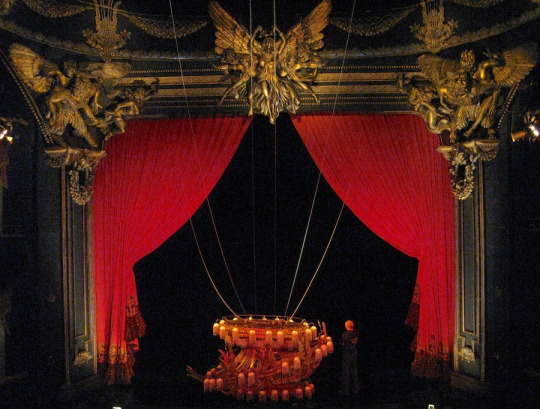
The Stockholm revival production was staged in a circular theatre, which meant there were not too many bearing constructions to attach the proscenium to, and the layout of the theatre meant a lot of seats would get the side-view blocked by eventual sculptures. So they kept the main proscenium, which was from the World Tour, but didn't do the lower side sculptures. Unlike the original Sctokholm production they didn't add an additional ornament either:
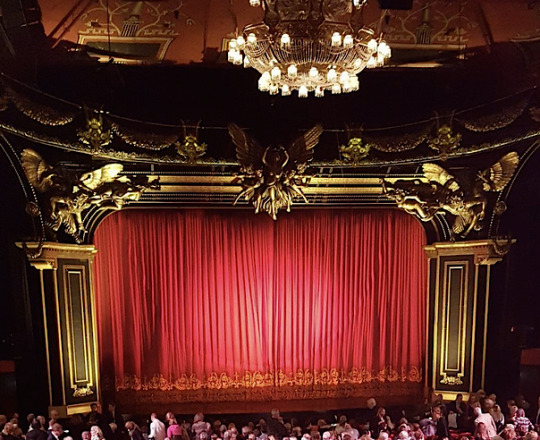
Then the rare case of the "double proscenium" in the original Viennese production. Due to the layout of the auditorium the top sculptures were placed in the outer area, while the lower side sculptures was moved in on stage.

Note that both the Stockholm/Copenhagen version, The Japanese version and the Viennese version was designed by Maria Bjørnson herself. It was her way of taking the original set-up and adapt it to the specific theatres. Ideally the proscenium should look like a part of the auditorium, blurring the lines between stage and audience, and for this elements has to be switched around. She was however very thorough with the placement of the Golden Angel and the surrouding garlands and lyres, making this a continuous curving line.
I think my all-time favourite of prosceniums matching the auditorium is the Paris set-up. It just... melts into the auditorium! They also did the whole shebang, all sculptures, all details. Aaaah!

My love for the World Tour is endless, but I really wish they would beef up that proscenium. The lack of the Golden Angel and the lack of the lower side sculptures makes it look a bit... boxy. A middle ornament of some sort and a wreath like Stockholm / Copenhagen would have softened the look considerably.

I could go on about the changes in the new prosceniums, the lack of side sculptures, lack of the Golden Angel, or the extended Las Vegas set, whatnot. But that's for another photoset. This one is rather a homage to the original design and various adaptions of it.
28 notes
·
View notes
Text
An old Viennese friend once remarked that the Germans have a bad habit of embracing righteous moral causes and then doing terrible things in their pursuit of these causes.
“It’s the downside of German diligence and organization,” he points out. “Once the Germans decide they are going to do something—even it’s a stupid idea—they are likely to do it with dreadful thoroughness.”
We recently saw this with Germany’s diligent pursuit of “Green Energy,” thereby wrecking its manufacturing sector, which was, for decades, the envy of the world.
Then there was the German government’s fanatical pursuit of the most draconian pandemic policies, which the late pianist, Stefan Mickisch, correctly characterized as Corona Fascism, and which the American expat author, C.J. Hopkins, bravely protested.
Now comes the news that Germany’s new Chancellor—former BlackRock executive Friedrich Merz—wants to rearm Germany and supply Ukraine with long range Taurus cruise missiles, which would be a tacit German declaration of war against Russia. The last time Germany did that, it ended very badly for Germany.
12 notes
·
View notes
Text

COMPREHENSIVE DESCRIPTION OF MOZART'S FUNERAL
The funeral of Wolfgang Amadeus Mozart, held on December 6, 1791, was a modest and somber event shaped by the social and economic circumstances of the time and the lack of resources available to his family.
PREPARATIONS AND ORGANIZATION
ECONOMIC CIRCUMSTANCES:
Mozart died leaving his family in a precarious financial situation. His wife, Constanze, had very little money to cover basic costs.
The funeral expenses amounted to 8 florins and 36 kreutzers, corresponding to the "third-class burial," a common and economical option for the Viennese middle class.
LOCATION AND DATE:
The funeral took place at St. Stephen’s Cathedral (Stephansdom) in Vienna.
A brief blessing ceremony was held in a side chapel of the north transept on December 6, 1791, the day after his death.
BURIAL DECISION:
Mozart was buried in St. Marx Cemetery (St. Marxer Friedhof), located on the outskirts of Vienna.
No individual grave was purchased; instead, he was interred in a communal grave, a standard practice for third-class burials.
THE DAY OF THE FUNERAL
WEATHER CONDITIONS:
The ceremony occurred during a snowstorm with heavy rain, making attendance difficult and prompting the few attendees to abandon the procession before reaching the burial site.
ATTENDEES:
Gottfried van Swieten: A close friend and patron of Mozart, known for supporting his career and organizing the funeral.
Franz Xaver Süssmayr: Mozart’s disciple and collaborator, who later completed the Requiem.
Antonio Salieri: Despite the controversial relationship often ascribed to him and Mozart, Salieri attended the funeral as a gesture of respect.
Joseph Deiner: A servant and close friend of the Mozart family who assisted with funeral preparations and provided accounts of the events.
Other musicians and close friends: The full list of attendees remains undocumented, but low attendance is attributed to the severe weather and the funeral customs of the period.
ST. MARX CEMETERY
COMMUNAL GRAVE:
Mozart was buried in a communal grave designed to hold 15 to 20 bodies, a typical arrangement for third-class burials.
These graves were reused approximately every 10 years, with remains relocated, which explains why Mozart’s exact resting place remains unknown.
LACK OF MARKER:
Mozart’s grave was not marked with a cross or a headstone, due to both the customs of the time and the family’s limited financial means.
ATTEMPTS TO LOCATE THE GRAVE:
Years later, Constanze Mozart attempted to locate her husband’s grave, but the original gravedigger was no longer employed, leaving the site unidentified.
SUBSEQUENT REACTIONS
PRESS REPORTS:
The Wiener Zeitung published a brief obituary, recognizing Mozart as a musical genius and lamenting the irreparable loss to the world of music.
A letter from Prague (dated December 12, 1791) highlighted Vienna’s negligence in appreciating Mozart’s talent during his lifetime, emphasizing that his death would make many realize his significance.
IMPACT ON THE FAMILY:
Constanze was profoundly affected by Mozart’s death. Initially bedridden with grief, she received assistance from Van Swieten, who helped organize a benefit concert. The proceeds allowed her to settle debts and secure a future for herself and her children.
HISTORICAL INTERPRETATION
Mozart’s funeral reflects the 18th-century Viennese burial customs, which rarely distinguished between social classes except for the nobility. While the event was understated, its historical significance is immense: it marked the end of a brilliant life and the beginning of an eternal musical legacy. The contrast between the modesty of his burial and the grandeur of his work remains a powerful symbol of a genius not fully recognized in his lifetime.
SOURCES
1. Otto Jahn – The Life of Mozart
2. H.C. Robbins Landon – Mozart: The Final Years
3. Christoph Wolff – Mozart’s Requiem: Historical and Analytical Studies
4. David Schroeder – Mozart's Death: A Corrective Look
5. Historical records from St. Marx Cemetery and St. Stephen’s Cathedral archives
Thank you Alex Rosas Navarro FB @Mozart Group
#mozart#mozart life#wolfgang amadeus mozart#classical composer#classical history#classical music#classical art#classical instruments#18th century#classical
9 notes
·
View notes
Text
Wednesday 7th May 2025
Zamora, I think you can safely say, scrubs up well. It was originally, Semure, a Roman settlement on what was known as the Silver Route; a Roman road that ran north to south through the Liberian peninsular, pretty much, funnily enough, the way we are following. Originally, a trade route including precious metals. Later, subject to many incursions by Muslim forces, but eventually stabilised and by the 10th century became a strategic outpost of the Kingdom of León. They built the city walls that can be seen intact today as well as 24 churches in the Romanesque style; the greatest number anywhere. So it was that we started our day with a stroll around the Cathedral, which began its life as a pile of rocks in 1151. Quite a beautiful, peaceful place with some amazing silverware behind the main alter. Our venture into Romanesque then took us to the other 23 churches, which is a lot, especially when they look extremely similar. A common feature, however, on many of the towers were nesting storks, high up on the spires and encouraged because they are thought lucky. A walk across the wide Douro along the old Stone bridge dating back to the start of the 13th century. From there, we could see stretching across the flow of the mighty river, Mills designed to grind flour and olives and were likely to have been operated by the estates of the Cathedral.
So, I do, on reflection, feel a bit disappointed at the attitude of our hero LL. We have spent a day being amazed at the beauty of this lovely old town, and all he could find to do was drink a lot of beer, dance to some Viennese music and then be on his way again the very next day!
Having had a small siesta midafternoon back in our little apartment, we set off to pop into the Inglesia de Santa Maria Magdalena around the corner on route to the supermarket. Jolly nice little church of late 12th century specification and was used as a council church until the 1835 Spanish Confiscation. €1 entry, no concessions. It's interesting that as the sun lowers in the sky, people here immerge on the streets to promenade; the little bar by the park fills, children play on the grass, and the place comes alive.
We continue to only achieve high teens in temperatures, but it has once again been sunshine and blue skies.
Tomorrow, we take to the road again following Laurie's route, the next stop being Valladolid via Toro. We just hope that he has much to report.


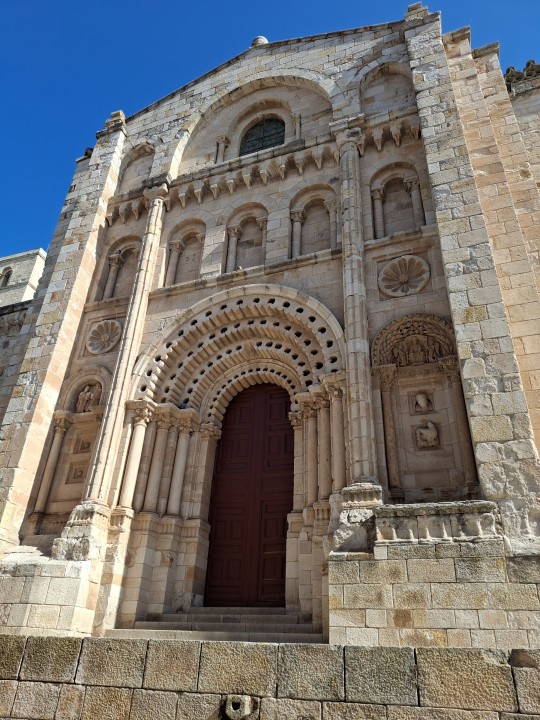







3 notes
·
View notes
Text


The somewhat strange & unexpected connection of Architects’s Joesph Urban’s “The New School” & Mar A Largo.
In 1919, several professors at Columbia University took a public stand against America’s entry into the First World War. Having been censured by Columbia’s President, they resigned in protest, fearing that academic freedom was in danger. They joined up with other progressive educators to found the New School for Social Research (later renamed The New School) which focused on adult education. The NSSR was housed in six leased brownstones on West 23rd Street, Chelsea.
As the lease was coming to a close, its Director Alvin Johnson decided to create a permanent home for the school, one that would give visible form to its identity and ideals. A fundraising plan was needed, along with a visionary design that would inspire potential backers (in a time of deepening financial crisis). Two architects were shortlisted, Frank Lloyd Wright and Joseph Urban. Johnson convinced the Board of Directors that the latter was the best choice.
Urban’s design was driven by Bauhaus principles. Completed in 1931 and believed to be the first International Style structure built in the United States, the New School at 66 West 12th Street in Greenwich Village was the designer’s last architectural work before his death in 1933.
Alarmed by the growing threat posed by Adolf Hitler, Alvin Johnson began offering positions to scholars who had fled the Third Reich. Their presence initiated the formation of a University in Exile which eventually consisted of more than 180 exiled faculty members. Some scholars who were offered a place at the institution never reached its premise.
The University in Exile program was originally funded by contributions from Hiram Halle and the Rockefeller Foundation. In 1934, it was chartered by the State of New York and changed its name to Graduate Faculty of Political and Social Science.
In 2018, the New School University in Exile Consortium was established to continue the mission of the original group by providing support and space to exiled or persecuted scholars.
Two buildings and a single architect – one is an extravagant 1920s Art Deco residence that mirrors the senseless opulence of private wealth; the other is a functional Bauhaus structure that represents both the sobering realities of the 1930s (in New York itself and in Urban’s native Vienna) and the urgent need for social sciences to intervene.
Mar-a-Lago
When New York turned icy, Urban removed himself to Florida. There, amongst other activities, he oversaw the building of the exclusive Bath & Tennis Club in Palm Beach. The rest of the year, he and his wife lived in style at the St. Regis Hotel at East 55th Street, Manhattan.
In 1924 Marjorie Merriweather Post, heiress of a vast family fortune made in the cereal business, commissioned Urban to design a “Spanish style” villa complex in Palm Beach. Named Mar-a-Lago, the estate was completed three years later.
Having called in the support of his former Hagenbund colleague, the Viennese sculptor Franz Barwig, Urban’s design exuded an air of exotica and grandeur. The mansion featured Spanish tiles, Florentine frescoes, and Venetian arches. With a panoramic view of the Ocean, it had a ballroom, a nine-hole golf course, and an underground tunnel linking the estate to the Bath & Tennis Club.
#warneryork#interiors#nyc#aesthetic#interiordesign#original art#classic#abstract#painting#mixed media#Joseph Urban
4 notes
·
View notes